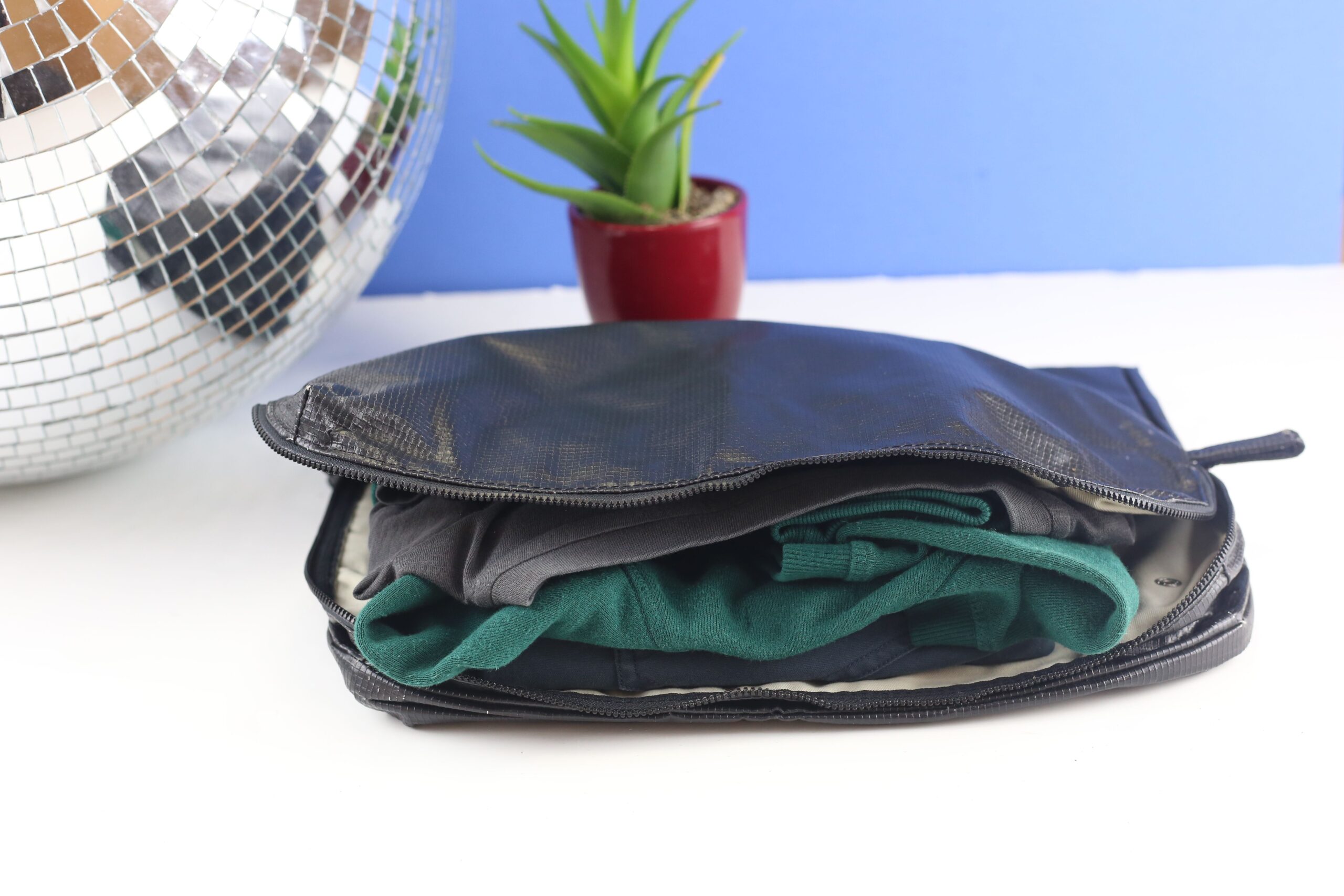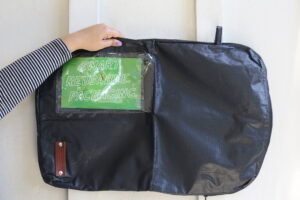No one likes polybags. And even though the single-use plastic pieces serve a necessary purpose for protecting garments for online apparel merchants, brand manufacturer Toad & Co. still wanted to get rid of them.
“Polybags are the worst thing in the world. Everyone hates them but they are a necessary evil,” says Steve McCann, marketing director at Toad and Co.
Polybags are the clear plastic bags the nearly all apparel items are shipped in. But brands can’t just get rid of them without a replacement. Retailers need something to shield a garment from the elements as it makes its way through a warehouse on a belt, being picked, packed and shipped and making its way on a ship, truck or van or all three to a store or to a shopper’s doorstep, where it may encounter rain, snow and sleet. If the product gets damaged at any point, it will be thrown out.
“The lifecycle of ruining a garment versus the lifecycle of a polybag is much worse,” McCann says.
Since Toad and Co. started selling online in 2014, the brand went from using one traditional polybag, to optimizing the design to be more sustainable in five different sizes. It aims to eliminate polybags completely by 2024.
Shipping a ‘better’ polybag
The brand’s first iteration of making its polybags more sustainable was shrinking the standard width of each polybag to better fit its garments. What’s more, instead of using one larger polybag that would hold any of its products, it invested in polybags of different sizes so that each bag fits the garment, reducing the plastic required. It also thinned out the plastic to further minimize the amount of plastic used.

Steve McCann, marketing director at Toad and Co.
In addition, Toad and Co. changed the location of the airholes on its polybags. It moved them from the bottom of the bag to the top and alerted shoppers these polybags could be reused to pick up dog waste, McCann says.
And even after all these efforts, the retailer is working to eliminate all these polybags.
One alternative packaging retailers use is a compostable polybag made out of plant-based materials. These bags, however, have mixed reviews from vendors and merchants. While compostable materials could be better environmentally than single-use plastic, it’s challenging for consumers to get the bag to the proper facility. A consumer would have to drop them off at a collection point that takes this specific material. If a consumer throws out this material it could emit more methane in a landfill than other types of trash, according to several vendors, analysts and retailers. And if a consumer puts the bag in the normal recycling bin, it could clog and contaminate the normal recycling process, causing the entire batch of recycling to end up in a landfill.
Toad and Co. switches to paper polybags
Because of these issues, in 2020 Toad & Co. started working with packaging vendor Vela to pilot its paper polybags. They are made of Forest Stewardship Council-certified paper and can be recycled with mixed paper. This makes them much more likely to actually get recycled than a compostable bag. FSC is a nonprofit organization that ensures the paper is from a forest that is responsibly managed for environmental, economic and social benefits.
After piloting the paper polybags with a few products, the retailer confirmed they were sturdy enough to protect its garments and of the same quality as a traditional polybag, and began rolling them out across all of its products. Once the brand hits a certain minimum order volume of products at each of its factories, it makes the switch to using this product. As of Q2 2023, about 82% of its products use the alternative polybag and by spring 2024, 100% of them will, McCann says.
Toad and Co.’s shoppers have not commented on the switch in materials, but its wholesale accounts have reacted positively, McCann says. When brands ship items to stores, just like to a shopper’s home, each garment is encased in a polybag. Store employees open each bag and hang the garments up.
“They see it more so than anyone else, this is so much waste and so much plastic,” McCann says.
About 50% of Toad and Co.’s sales are direct-to-consumer online and the other half are wholesale to retailers, he says.
A more dramatic alternative: reusable packaging
To further lower its carbon footprint, Toad and Co. also gives shoppers the option to have their orders shipped in a reusable package. With vendor LimeLoop, Toad and Co. rents weatherproof bags. The bags are made of recycled polyester, mostly old billboards, on the outside. They have a zipper closure instead of tape and are recycled cotton on the inside.
For each LimeLoop medium bag, a retailer reduces 92% of carbon dioxide emissions and 99% of water use compared with shipping that order in a medium size cardboard box, according to LimeLoop. Similarly, for each LimeLoop small bag, a retailer reduces 42% of its carbon dioxide emissions and 9% of its water use compared with a polymailer plastic bag, according to the vendor.
The retailer piloted LimeLoop in 2018 and was one of its first clients. Its relationship ebbed and flowed throughout the years, as Toad and Co. has paused and resumed the service as it replatformed its ecommerce site and moved warehouses.
Here’s how it works: On the checkout page, shoppers can choose four shipping options, free standard, free standard with a LimeLoop mailer bag, paid second day or paid next day. If a shopper selects the LimeLoop option, her order will arrive in a reusable bag with instructions on how to return the bag. Once the shopper decides if she is keeping her entire order or is returning items, she visits ToadandCo.com to print a free return label. She puts the label it in the front sleeve of the bag and can drop it off in any U.S. postal service mailbox.

Toad and Co. commits to less packaging by sending orders in reusable bags.
Toad and Co. shoppers use LimeLoop
About 12-15% of Toad and Co.’s online shoppers select the LimeLoop package option, and 20% of those who chose LimeLoop as their fulfillment method, choose it again, McCann says. These are healthy numbers, McCann says, especially when considering how many new customers Toad and Co. has, he says without revealing more. For non-LimeLoop orders, Toad and Co. ships products in a 100% recycled paper mailer with water-based inks to ensure shoppers can recycled the bag.
Unlike thinning its polybags and increasing the number of polybag sizes it uses, the LimeLoop sustainable packaging is highly visible to the customer and something Toad and Co. receives a lot of positive feedback on, McCann says.
“It’s something that people when they look out their window, they get it. They get how many boxes they get from Amazon that you can’t even fit it all in your recycling bin anymore,” McCann says. “[Shoppers] understand it’s an issue, but they don’t see anyone doing anything about it. But they also love the convenience of [online shopping] and are not willing to change the convenience aspects. I think when brands have an option and it’s different and it’s addressing the issue, they love it and grab on to it.”
Printing the return label is a barrier for shoppers to using the service, McCann says. It is still working on the logistics of getting its systems to talk to each other to include the label with the package and how that would work if a shopper decides to return any number of items. LimeLoop says most of its clients include the return label with a package. LimeLoop has 45 online retail clients, mostly small businesses with annual revenue less than $5 million.
Challenges in getting the LimeLoop bags back
It takes about two weeks from when Toad and Co. ships an order to when it receives the bag back, a speed the retailer is continually trying to get faster, McCann says. The more it can reuse the bags, the better.
If Toad and Co. can use a LimeLoop package twice in one month, it breaks even in cost compared with traditional packaging. Otherwise, this shipping method is more expensive, McCann says without revealing more. LimeLoop rents the bags to retailers for about $1 per bag per month, and they can be used at least 200 times, the vendor says. So far in 2023, Toadandco.com has hit the twice-a-month frequency for each bag.
“Our benchmark KPI is that turnaround time,” McCann says.
When Toad and Co. first started using LimeLoop bags, it had trouble getting shoppers to return the bags, as some thought they were theirs to keep.
“The biggest part of the pilot learning was about the returns and how to communicate with customers,” McCann says.
In surveys, Toad and Co. learned that shoppers may take a few days to open their package once it arrives and then a few days to try on items and then decide what they want to keep. Then they have to print a label, which they may have to leave their house to do, and then put the bag in the mail. This all takes time.

About 12-15% of Toad and Co.’s online shoppers select the LimeLoop package option.
Toad and Co. learned that it needed to communicate urgency about returning the bags and educate shoppers in its emails about the importance of sending the bag back quickly in order for the process to be a sustainable option.
Communication with customers
In the five years since piloting the feature, industry standards have changed around communication with shoppers, McCann says. Previously, Toad and Co. hesitated to email customers more than three times a week, but now it has no issue contacting shoppers every day, McCann says. It can automatically send reminder emails via LimeLoop, as its systems know which customers haven’t returned their bags yet.
The vendor says some of its clients charge a few dollars as a deposit to customers to use the LimeLoop bag that retailers refund once they receive the bag back in the mail.
“This helps to keep the reusable packages always in motion and many clients utilize this feature,” a LimeLoop spokesperson says.
Bernardine Wu, executive managing director of digital strategy at digital consultancy OSF Digital, says LimeLoop is an interesting packaging vendor to watch, as it provides a sustainable packaging initiative that can scale and make an impact.
Integrating LimeLoop
It took a few months to integrate LimeLoop into all of the systems, McCann says. The retailer has done this twice, once when it launched, and then again in 2022 after a few months of program pause while it replatformed to a Shopify ecommerce site and moved warehouses.
When a shopper selects LimeLoop, the warehouse needs to know which order is selected for that package, as does its ordering platform, and shipping and return vendors. All of these integrations have to be built into its systems.
The merchant also had to learn how many shoppers would actually choose this option and how that correlates to how many LimeLoop bags it needs. Initially, Toad and Co. had 400 bags and it would frequently run out of them. Then, it couldn’t offer the option to shoppers until it received a bag back. In 2022 it invested in more bags for now a total of 2,800 and it no longer runs outs of bags.
Even though the system seems complex, Toad and Co. is happy with the program and the customer response. When Toad and Co. communicates to shoppers about the program either via email or on social media, those communication pieces always receive lots of feedback, McCann says.
While it wants to encourage more shoppers to choose this option, it is going to leave it at that, an option, McCann says.
“We can encourage and education and let people make an educated decision on what they want to do,” McCann says.
Toad and Co. is No. 1623 in the 2022 Digital Commerce 360 Next 1000.
Sign up
Stay on top of the latest developments in the ecommerce industry. Sign up for a complimentary subscription to Digital Commerce 360 Retail News.
Follow us on LinkedIn, Twitter and Facebook. Be the first to know when Digital Commerce 360 publishes news content.